Your Planets
Portraits of the Planets
Aspects between Planets
The planetary ages
The planetary families
Planets in Signs
The Planets in comics


“The Logoscope is not astrological, and cannot be reduced to any typology… The R.E.T. lends itself to a typology because it is the adaptation of the Logoscope to a referential, the Relation, where a few well-chosen criteria can be converted into character evaluations… But proceeding from the Logoscope, the R.E.T. bears his mark: analyzer of existing typologies, grid of homogeneity, he shows the imbalances. Grid for organizing coupled functions, it can be the tool for new typologies. To understand these multiple possibilities, it takes a minimum of awareness of the Transcendence of the Object repository, which in modern language is translated by logic of systems or systemic” (J.-P. Nicola).
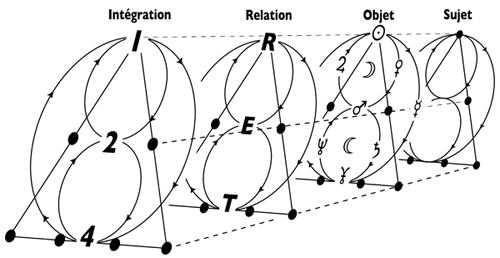
“Conditionalist language from traditional heritage is more universal than astrology. The functions of the R.E.T., although qualified as planetary, do not come from the stars but from the forces and structures of which they are the manifest vectors in the solar system. In its elementary digital form (interactions between one, two, many), at the atomic scale, the R.E.T. does not lead to consultation and does not inspire global predictions. Is it less present and less active? Molecules, also organized in simple, dual, multiple hierarchies, are part of the R.E.T.… and of the solar system, without being in our ephemeris. In chemistry and biochemistry, physics and biophysics, energy transformations relate the high, medium and low levels of R.E.T. qualitative. Interactions again between giant, medium and dwarf galaxies; clusters, close, less close, distant.” (Jean-Pierre Nicola).
 Any situation can be described according to four fundamental parameters:
Any situation can be described according to four fundamental parameters:
▶ a Subject (you or me) faces
▶ a Object (a being, a thing, an idea, a profession, a passion, a situation, a work, etc., which are external to the Subject). From this confrontation between Subject and Object is born
▶ a Relationship (consonant or dissonant, easy or difficult, continuous or discontinuous), which produces
▶ a Integration (a coherent or incoherent whole, depending on the nature of the Relationship between Subject and Object)
Conversely, all Subject is the result of Integration (successful or not) of its Relationships (good or bad) with Objects (adequate or not) previous. The relationships between Subject, Object, Relationship and Integration are therefore relations flyers.
Example: what is astrology about? On the Integration of Man into the Universe. This Integration is the cosmic environment within which is established the Relationship that the human Subject maintains with the Objects of his terrestrial and celestial environment. We have already seen: the horoscope is not the Subject. What we call the Subject (an individual isolated from his environment by a discourse) is the structural and historical product of the interactions between his terrestrial heritage and his celestial heritage. The planetary and zodiacal configurations at his birth (his birth chart, which induces a timeline), his genetic baggage, his relationship to his mother, his socio-cultural background, all of this contributed, among other things, to constituting a Subject: an individual with certain social, affective or mental aptitudes, a specific character, a personal outlook on the world.
Should we also invoke or evoke determinisms “karmic”, that is to say the sequelae, rewards and punishments due to the actions of the Subject during his previous lives? Why not, for those who believe in reincarnation. It doesn’t change anything about us: “the Subject is indeed the product of previous Integrations” (J.-P. Nicola). He comes into the world loaded with selective memories which will condition, whether he is aware of it or not, his experience-Universe. The Subject is Integration of the World:
“For two identical skies, what are the solutions in terms of size, quality, scope? The causes are unequal and multiple. There are all the extra-horoscopic factors which are so many external objects that the tendency can invest in order to adapt, develop, sublimate itself. The fate of the trend is not independent of the choice and nature of the object” (J.-P. Nicola).
Here we are (again): the natal horoscope is a global and hierarchical set of tendencies, of potentialities of the Subject which require to be actualized, to materialize by investing in an Object. And the goal of all serious astrological consultation is to help the Subject to find his Object, that is to say the work, the profession or the partner which will allow him to realize as best as possible the potentialities expressed by his birth sky and his earthly experience.
 When the Subject has what is called the “vocation”, this hardly poses a problem: he instinctively and spontaneously chooses the Object that suits him, grafts his astral tendencies to it without frustration, with such a quality of Relationship that his Integration flows naturally. And the Subject projecting itself into its Object which reflects it almost perfectly, it is tempting to reduce this Object to an extension, a projection of the Subject.
When the Subject has what is called the “vocation”, this hardly poses a problem: he instinctively and spontaneously chooses the Object that suits him, grafts his astral tendencies to it without frustration, with such a quality of Relationship that his Integration flows naturally. And the Subject projecting itself into its Object which reflects it almost perfectly, it is tempting to reduce this Object to an extension, a projection of the Subject.
But how many of us actually have the leisure or opportunity to choose our job, their emotional partner, their work to be done? Very little in fact. Most of the time we need (Subject) “do with” a human, historical, geographical, social, cultural, political, economic, spiritual environment (Object), which we have not chosen and to which we are obliged to try to adapt fit. Very often, we take the job that we find or the one for which we were programmed during our studies, and not the one we dream of. And in order to survive, we sometimes spend a lifetime practicing a profession (Object) to which we feel deeply foreign (Subject).
The S.O.R.I. (initials of Subject, Object, Relationship and Integration) is essential in describing the relationship between the individual, his birth chart and the rest of the world. The S.O.R.I. integrate the model R.E.T., which itself integrates the zodiac. Indeed, it is impossible, by analyzing a Chart, to know if the individual who lives this Chart is subjective or objective. And yet, there is a real gulf that separates subjectivity from objectivity.
Before specifying what these two notions cover, let’s illustrate them concretely:
▶ subjective point of view
Example: such an individual was born under an opposition Venus-Saturn dominant, which makes him aware of the complexity and difficulty of affective attachments. If he is subjective and feels this aspect very badly, he will form, for example, of the outside, objective world, the following opinion: “Life is only the painful experience of unhappy loves.” Likewise, a subjective astrologer will interpret this aspect thus: “If you fail to find emotional happiness, it is the fault of your Venus-Saturn opposition.”
▶ objective point of view
Example: this time we are dealing with an individual who is as objective as possible. With the same Venus-Saturn opposition, his vision of the world this time will be the following: “Since I work like this, I tend more than others to decipher my experience of the world through the prism of a Venus-Saturn dissonance, which in no way excludes other approaches to reality.” And the interpretation of an objective astrologer will also be much more nuanced, like: “The Venus-Saturn dissonance makes you, more than others, aware of the complexity of emotional ties. You will eventually be able to satisfy this tendency by investing it in a being who, like you, is not satisfied with too simple happiness. Whether you succeed or not, you will in any case be more gifted than others at identifying when, in what and how a being, a situation or a work objectively stems from an affective lack.”
It can be extremely difficult, if not impossible, to really communicate with the subjective individual of example No. 1, unless you share in all respects his subjective vision of the world and the beings who inhabit it, which is reduced to the axiom “There is no happy love”. And it will be futile to try to convince him that objectively, all human phenomena cannot be reduced to this axiom. On the other hand, communication can be much easier, even if you don’t share your point of view, with the individual in example No. 2, who has the same chart but who is objective. We will then confront different visions of the world, knowing that each, according to their chart and their experience, testifies to reality in their own way.
| Subject | Object | Relationship | Integration |

| Excitability | Signal | Communication | Symbol |
| High level Medium level Low level |
Simple Compound Complex |
Representation Existence Transcendence |
Unique Duel Multiple |
| Energy | Space | Time | Structure |
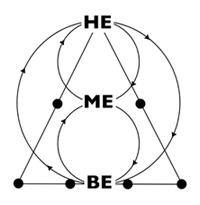 On the level of the Subject, each of us “see things his/her own way” (a popular expression that perfectly describes subjectivity). Each of us, whether we are aware of it or not, looks at, interprets and judges the outside world through the distorting glasses of our own history. A story made up of his beliefs, his sensitivity, his a priori, prejudices and prejudices hyper-conditioned by the education, the society and the culture from which he comes and by the personal experiences he has lived.
On the level of the Subject, each of us “see things his/her own way” (a popular expression that perfectly describes subjectivity). Each of us, whether we are aware of it or not, looks at, interprets and judges the outside world through the distorting glasses of our own history. A story made up of his beliefs, his sensitivity, his a priori, prejudices and prejudices hyper-conditioned by the education, the society and the culture from which he comes and by the personal experiences he has lived.
The subjective individual thus constructs a vision of the world and a self-image that are very often far removed from objective realities, and sometimes even in total contradiction with them. The Subject finds it difficult to decenter from his own point of view, to question himself fundamentally: it is extremely difficult for him to distance himself from himself. The Ego-Subject wants to be foreign to the world in which it participates and of which it is only ever one of the emanations. He does not understand that the objective universe resists his projections, his will, his desire.
Two subjective individuals in the process of communicating generally have a dialogue of the deaf — unless they share the same prejudices, in which case the communication is reduced to two self-confirmations through the mirror of an inter-confirmation.
Astrologically speaking, no Planet, no Sign has the monopoly of subjectivity. To function subjectively, it suffices to conceive of the experience-universe only through the exclusive and intolerant filter of its dominant planets… which inevitably leads to the refusal of other testimonies, for example those expressed by other Subjects in which the planetary dominants are exactly opposite. For a subjectively blind person, the world is blind. For a one-eyed person, he is one-eyed. For a subjective Solar, Marsian or Plutonian, it is solar, marsian or plutonian…
The astrologer J.-P. Nicola developed a theoretical hypothesis regarding the meaning of Houses from the interactions between the R.E.T. and the S.O.R.I. (see Anthologie astrologique, volume 1, and Le grand livre de l’astrologue, op. quoted). According to this theory, Houses I-V−IX would sensitize to the Subject frame of reference, Houses II-VI-X to Object, Houses III-VII-XI to Relationship and Houses IV-VIII-XII to Integration. But not all conditionalists agree on this subject.
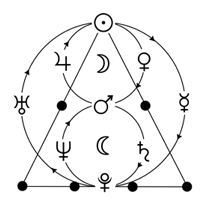 On the level of the Object, everything changes. We come out of the reassuring den of our subjectivity, we strip ourselves of our prejudices, we decenter ourselves. Sure, it’s always noon at my door, but what time is it for someone else, whose door opens or closes in another time zone? The object is “that which… exists independently of the mind (opposed to the subject who thinks)”.
On the level of the Object, everything changes. We come out of the reassuring den of our subjectivity, we strip ourselves of our prejudices, we decenter ourselves. Sure, it’s always noon at my door, but what time is it for someone else, whose door opens or closes in another time zone? The object is “that which… exists independently of the mind (opposed to the subject who thinks)”.
The successful encounter with the Object allows the Subject to decenter, to see himself doing and saying, to no longer allow himself to be blinded by the lark mirror of his subjectivity. By being objective, one can understand and possibly accept — if it is justified — a point of view at the antipodes of one’s own: when it is day in the northern hemisphere, it is night in the south. It is no longer myths, beliefs and personal projections that judge what is fair and unfair, true and false, but objective realities. The object world is not a fabric of intertwined subjectivities, but an interpersonal reality: it exists in itself, it has its own laws, its structures, its own organization, irreducible to what the Subject thinks.
Of course, we are all prisoners of our subjectivity: the Subject can therefore only try to be as objective as possible. There quantum physics demonstrated the constant interaction between observing Subject and observed Object: if the Object is subjective, in the sense that it is the result of an observation, the opposite is also true: the Subject can be objective…
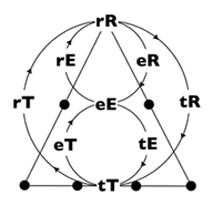 The Relationship is “the character of two objects which are such that a modification of one leads to a modification of the other.” Relationship is also a repository that has its own laws, organization and structures. It is possible to analyze the nature, properties and form of a Relationship independently of the respective qualities of the elements that constitute it. Is this relationship linear or circular? Continuous or discontinuous? Momentary or permanent? Weak or powerful? Conscious or unconscious? Imaginary or real? Order or equivalence? Etc. The Relationship is interactive. It modifies the intrinsic properties of the Subject and the Object that it unites. The Self-Subject is itself only because the Other-Object exists, which is perhaps only another Self-Subject. We exchange, we distribute, we negotiate, we coordinate, and in doing so we inter-modify.
The Relationship is “the character of two objects which are such that a modification of one leads to a modification of the other.” Relationship is also a repository that has its own laws, organization and structures. It is possible to analyze the nature, properties and form of a Relationship independently of the respective qualities of the elements that constitute it. Is this relationship linear or circular? Continuous or discontinuous? Momentary or permanent? Weak or powerful? Conscious or unconscious? Imaginary or real? Order or equivalence? Etc. The Relationship is interactive. It modifies the intrinsic properties of the Subject and the Object that it unites. The Self-Subject is itself only because the Other-Object exists, which is perhaps only another Self-Subject. We exchange, we distribute, we negotiate, we coordinate, and in doing so we inter-modify.
Let’s take a concrete example of a Relation: the human couple. This couple is something other than the simple addition of two individuals: it is also a living entity, a reality in itself. When the Relationship (love, friendship or other) between two beings is homogeneous and fruitful, the objective differences are transformed into complementarities. The more time passes, the more each member of the couple “rubs off” on the other. Isn’t it said that very old couples united (that is to say, in a good relationship) end up strangely resembling each other, as if the duration of the relationship allowed each to become imbued with the character and behavior of the other?
Another example of a Relationship: the Company. This is not the sum of the members that compose it. It is a being of Relation which, as such, imposes its constraints, its laws and its organization on the Subjects that it brings together.
It is extremely difficult for the Subject to admit that the objective world resists his desires: subjectivity is the best shared and most common thing. Rarer already are individuals capable of objectivity. There are even fewer people who are truly sensitive to what the Relationship is: in this reference frame of the S.O.R.I., one must accept the loss of oneself (of the Self-Subject) in order to enrich oneself and metamorphose oneself in contact with the Other-Object. A genuine Relationship (which has nothing to do with dating, friendship or cronyism) is at this price.
 The Integration repository can be defined as the set, or the totality, within which Subjects and Objects are in Relation. On the level of Integration, the difference between Subject and Object is abolished, it no longer exists. There is only one big All. I inhabit the world that inhabits me. I am part of the Universe, and the Universe is part of me. At the Integration level, only the general climate, the ecosystem or the vast whole to which one belongs counts.
The Integration repository can be defined as the set, or the totality, within which Subjects and Objects are in Relation. On the level of Integration, the difference between Subject and Object is abolished, it no longer exists. There is only one big All. I inhabit the world that inhabits me. I am part of the Universe, and the Universe is part of me. At the Integration level, only the general climate, the ecosystem or the vast whole to which one belongs counts.
Example of Integration: what the Buddhism call him nirvana. The internal and the external, the subjective and the objective, the Self and the Other merge in a homogeneous Relationship: “The nirvana can be considered as an annihilation, a state of supreme serenity, a fusion of the individual soul and the collective soul.” We become one with Nature, the Cosmos, the Divine.
Another example of Integration, less mystical, is that constituted by a ecosystem. The ecosystem is “all living beings and non-living elements, with numerous interactions, of a natural environment”. The few billion Subjects that make up humanity are part of this integrating whole: “The atom, the molecule, the cell, the organism, the society fit together like a game of Russian dolls. The largest of these dolls has the dimensions of the planet. It encompasses human society and their economies. The cities and companies that are transforming the world. Living organisms and the cells that make them up.”
For an individual, to live in a state of Integration is to renounce any ego-voluntarist illusion, and to become what he is deep down: an insignificant cog in a vast whole, in a general climate that shapes him, impregnates it and overflows it on all sides. It is to follow and integrate its subtle and complex movements.
Each function, family or planetary aspect can be interpreted according to the four levels of the S.O.R.I. It suffices for this to combine the meanings of the ternary R.E.T. and the quaternary S.O.R.I.:

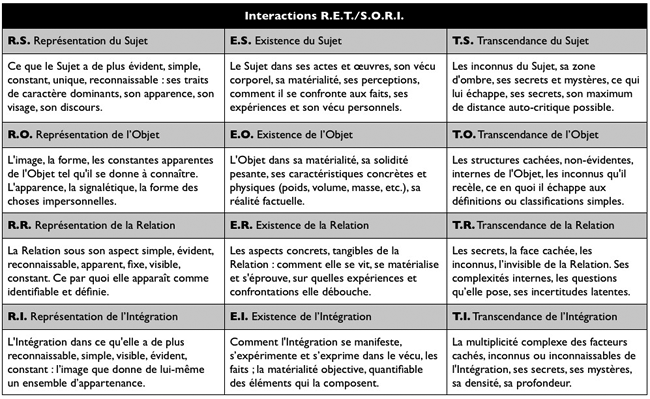
“With the S.O.R.I., we locate the reference of a language, we know — in advance — what its constraints, its facilities, its interferences in communication will be.”
Bring together in one place a rigorously subjective psychologist (who firmly believes that understanding the main lines of the functioning of a human being passes exclusively through the analysis of his dreams, his “complex” and the tribulations of his early childhood); a rigorously objective scientist (convinced that it is enough to know the genetic identity card of a human being to determine his behavior); a rigorously relational politician (one of those who are convinced that Man is the pure product of social relations, and that by transforming these, we will change that); and a monomaniacal mystic of Integration (who will never give up on the fact that we are all only a tiny part, a reflection of the divine reality within which “everything is in everything and vice versa”.
The four being reunited, try to make them communicate calmly. If none of them is aware of the relative level (S, O, R, I) at which they stand and from which they speak, how will they not only be able to understand each other, but also understand the multiple facets of man? In the best case, each may be right in his field, but globally wrong in that he will only perceive part of the reality.
To communicate, it is necessary to agree on a frame of reference, a language… With the S.O.R.I., we know where and what we are talking about. The four levels of the S.O.R.I. (Subject, Object, Relation, Integration) are equally real, but none are self-sufficient — since they mutually define each other — and above all, none are the exclusive property of a specialist caste.
It is not necessary to be a mystic to live or talk about Integration, to be a politician or a qualified sociologist to evoke the Relationship, to be an official member of the Academy of Hard Sciences to have glimmers on the Object, nor to be Freudian psychoanalyst or otherwise to interpret the Subject’s psychic states.
Astrology, on the other hand, seems to favor the referential “Relationship”. This plan, in fact, maintains the differences between the Man-Subject and the sky-Object without transforming them into antagonisms, and demonstrates their structural similarities without abolishing their differences (what is above is not like this). which is below: it is practically impossible to confuse a man with a planet).
Man is on Earth and the planets in the Sky… the Whole forms an integrated and integrating system, of course, but the Object of astrology is indeed the study of a Relationship: that of Man with the solar system. And this Relationship is only one of the many possible Relationships within the physical cosmos and the metaphysical universe.
In current astro-psychological practice, the planets are generally interpreted at the level “Subject”. In this perspective, the planets are considered as instigators of psychological functions determining, to a large extent, the functioning of the individual. The interpretations of Planetary aspects are quite characteristic of this reference plane.
But astrology cannot be reduced to astro-psychology: the R.E.T. can be used to decode, decrypt and decipher many realities which do not depend in any way on the psychological functioning of any Subject. And moreover, the interpretation of a chart will not be the same, depending on whether we are dealing with a rather subjective or rather objective individual.
The following anecdote illustrates this phenomenon: a nuclear physicist had asked an astrologer friend to interpret his chart, which was characterized by a dominant “Aquarius-T”. The astrologer friend in question had then given him an essentially subjective interpretation of his psychological functioning according to his natal horoscope. This is the very type of interpretation that you would be required to make if you were referring exclusively to the interpretation of the Aspects of this site. However, the physicist had not felt at all concerned by this interpretation. Worse still: he didn’t even seem to be trying to get into it “recognize”. Not stupid, the astrologer transposed the interpretation of “Aquarius-T” on the level of the Object, interpreting then, not the psychological functioning of the physicist, but the way in which he conceived objective reality. This time, the physicist fully agreed that this interpretation of his chart described well the way in which he apprehended the Object. And when the astrologer re-transposed the interpretation “Object” In Subject, i.e., astro-psychological interpretation, the physicist admitted that was indeed the way it worked.
This physicist was non-Subject, in the sense that he never seemed to have been interested in how he himself worked. Self-analysis had never been his major preoccupation. To make him understand his chart, the astrologer had to leave the marked paths of subjective astro-psychology.
It happened to me to interpret the chart of an individual who was emerging from long years of psychiatric confinement during which he had been extensively dissected from the angle “pathological subject”. He got out of trouble thanks to his creativity: author-composer-guitarist, he warded off his evil of being through his songs. Rather than interpreting its chart from the angle “Subject” (pathological or not), I had preferred to synthetically interpret his works (Object) and see with him what Relationship he had established with them, because the important thing for him was not to know how he worked (Subject), but to what extent he had healed himself through his relationship with his songs.
It is impossible to interpret a chart in this way if one does not have the S.O.R.I.
▶ Le S.O.R.I., le caducée et l’I.R.O.S.
▶ Le modèle S.O.R.I. et les Maisons
▶ The issue of the meanings of the Houses
▶ Introduction to the S.O.R.I. system
▶ S.O.R.I., R.E.T., Logoscope, information, structures et fonctions
▶ À propos du Logoscope…

Les significations planétaires
par
620 pages. Illustrations en couleur.
La décision de ne traiter dans ce livre que des significations planétaires ne repose pas sur une sous-estimation du rôle des Signes du zodiaque et des Maisons. Le traditionnel trio Planètes-Zodiaque-Maisons est en effet l’expression d’une structure qui classe ces trois plans selon leur ordre de préséance et dans ce triptyque hiérarchisé, les Planètes occupent le premier rang.
La première partie de ce livre rassemble donc, sous une forme abondamment illustrée de schémas pédagogiques et tableaux explicatifs, une édition originale revue, augmentée et actualisée des textes consacrés aux significations planétaires telles qu’elles ont été définies par l’astrologie conditionaliste et une présentation détaillée des méthodes de hiérarchisation planétaire et d’interprétation accompagnées de nombreux exemples concrets illustrés par des Thèmes de célébrités.
La deuxième partie est consacrée, d’une part à une présentation critique des fondements traditionnels des significations planétaires, d’autre part à une présentation des rapports entre signaux et symboles, astrologie et psychologie. Enfin, la troisième partie présente brièvement les racines astrométriques des significations planétaires… et propose une voie de sortie de l’astrologie pour accéder à une plus vaste dimension noologique et spirituelle qui la prolonge et la contient.
Téléchargez-le dès maintenant dans notre boutique

Pluton planète naine : une erreur géante
par
117 pages. Illustrations en couleur.
Pluton ne fait plus partie des planètes majeures de notre système solaire : telle est la décision prise par une infime minorité d’astronomes lors de l’Assemblée Générale de l’Union Astronomique Internationale qui s’est tenue à Prague en août 2006. Elle est reléguée au rang de “planète naine”, au même titre que les nombreux astres découverts au-delà de son orbite.
Ce livre récapitule et analyse en détail le pourquoi et le comment de cette incroyable et irrationnelle décision contestée par de très nombreux astronomes de premier plan. Quelles sont les effets de cette “nanification” de Pluton sur son statut astrologique ? Faut-il remettre en question son influence et ses significations astro-psychologiques qui semblaient avérées depuis sa découverte en 1930 ? Les “plutoniens” ont-ils cessé d’exister depuis cette décision charlatanesque ? Ce livre pose également le problème des astres transplutoniens nouvellement découverts. Quel statut astrologique et quelles influences et significations précises leur accorder ?
Enfin, cet ouvrage propose une vision unitaire du système solaire qui démontre, chiffes et arguments rationnels à l’appui, que Pluton en est toujours un élément essentiel, ce qui est loin d’être le cas pour les autres astres au-delà de son orbite. Après avoir lu ce livre, vous saurez quoi répondre à ceux qui pensent avoir trouvé, avec l’exclusion de Pluton du cortège planétaire traditionnel, un nouvel argument contre l’astrologie !
Téléchargez-le dès maintenant dans notre boutique